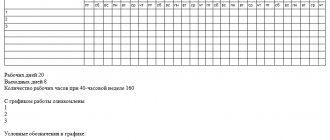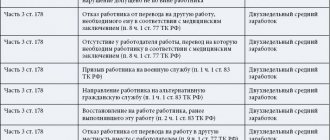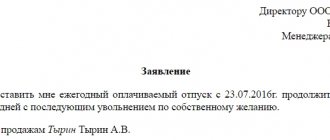How is an employee fired after working for 2 weeks? How to count it and what legal norms is it regulated?
It would seem that every working citizen knows the answer to this question. But in reality, you can encounter nuances that will baffle even a legally literate person. What does the law say about the need to work off upon dismissal? How is this period calculated correctly, and what days does it include? From what date is work counted upon dismissal?
We will talk about this in detail in this article.
In what cases is an employee required to work 14 days after submitting an application?
The very concept of “dismissal” in the Legislation means the termination of an employment agreement between an employee and an employer, and the subsequent termination of their professional relationship.
The severance of this relationship can be made for three reasons:
- by agreement of both parties;
- at the initiative of the employer;
- at the initiative of the employee.
In the latter case, according to the law, the employee is registered with the company for another two weeks from the date of filing the application.
This period is given to the employer in order to replace the employee. If he does not have time to find a new person for the vacant position, he still does not have the right to retain the employee in the company.
When the obligation is removed
It is permissible not to fulfill the obligation to notify the employer upon dismissal at one’s own request when the following circumstances are present:
- start date;
- joining the army;
- loss of ability to work;
- retirement;
- moving to another city;
- decree;
- other situations that do not allow you to continue working.
This is also important to know:
Dismissal by agreement of the parties with payment of compensation: how to formalize and calculate the amount of payment
Separately, the legislator identifies other circumstances that allow you to quit without working off. They are associated with violations of norms:
- non-payment or delay in payment of wages;
- denial of legal leave;
Such violations must be documented by authorized authorities:
- Labour Inspectorate;
- prosecutor's office;
- court.
In all of the above cases, the employee is fired on the day indicated by the application, without working off.
Cases when you do not need to work 2 weeks and who may not work them
Just as any rule has exceptions, there are also those who may not work upon dismissal. So, you can quit without having to work for a period of two weeks in the following cases:
- If there is an agreement between the parties on this issue. For example, a person who is planning to resign from a company has a good relationship with his employer, and he may well let him go without working the required period. Either the employer simply has no desire to keep him, or there is already a candidate for this position.
- Enrollment in an educational institution. If an employee has entered a college, institute or university, then he can quit without any problems and the director, in turn, is obliged to terminate his employment relationship on the day the former worker of the enterprise wrote a statement. But still, in this case, warn about your dismissal in advance.
- Retirement. Pensioners also do not need to work off, since they are not required to work at retirement age.
- Moving and a new place of residence or sending a spouse to a new location or abroad.
- Moving to a new place, if it is impossible to live in the previous one, due to health problems (must be confirmed with a medical certificate).
- Inability to do your job due to health problems.
- Caring for a child who has not yet reached 14 years of age or caring for a disabled child, it can also be caring for a sick relative or a disabled person of the 1st group.
- pregnant women or those raising 3 or more children under 16 years of age.
Summarizing all of the above, I would like to note once again the date from which the working period for dismissal is set - the countdown starts from the next day after the employer receives the employee’s statement of desire to resign. On the last day of the working day, the boss must pay you off and give you your work book.
How does the dismissal procedure involve mandatory two-week work?
Having decided to leave his position, the employee must submit a corresponding application to the employer. Despite the fact that in principle there is no statutory template for such a statement, the document must still include certain mandatory clauses.
The first and basic rule is that it must be in writing. Simply coming to the HR department and resigning by submitting a verbal application will not work.
The application must also contain the following mandatory items:
Free legal consultation We will answer your question in 5 minutes!
Ask a Question
Free legal consultation
We will answer your question in 5 minutes!
Ask a Question
- date of document preparation;
- day of dismissal (indicated by the employee);
- personal signature of the employee;
- basis for filing an application: in this column it is simply written “at one’s own request.”
According to the law, the employee is not required to describe the reason for leaving his position in detail. You can submit your application personally to your manager, write it to the HR department, or send it by mail with notification.
How many days in advance must you notify about leaving?
Dismissal with 2 weeks of work: how to calculate? The work must continue for two weeks.
It is 14 calendar days in advance that the employee needs to notify his manager of his desire to resign.
However, there are exceptions. Work off is 3 days in the following cases:
- If a person is on probation (Article 71 of the Labor Code of the Russian Federation).
- If a fixed-term employment contract was concluded for a period of no more than 2 months (Article 292 of the Labor Code of the Russian Federation).
But if the employee carried out seasonal agricultural work, then, based on Article 296 of the Labor Code of the Russian Federation, the working period is 7 days.
Employee's duty
According to Art. No. 80 of the Labor Code, an employee has the obligation to notify the employer in writing of leaving the organization fourteen days in advance. Therefore, in standard cases, dismissal with 2 weeks of work is used. There are also additional legislation establishing other periods. The employee is obliged to notify the employer in advance of the following periods:
three days:
- if the trial period has not yet ended;
- for workers in seasonal work;
- when the contract is concluded for a period of no more than two months.
one month:
- the employee holds a leadership position;
- for athletes and coaches when the contract period is more than four months.
Many people mistakenly equate the obligation to give an employer two weeks' notice to "working off." There is actually no need to actually work this time.
It does not matter whether the employee works during this period, is on vacation or on sick leave. The law establishes only a minimum period of written notification to the employer of the fact of leaving the company.
Important! When the manager agrees, you can resign before the end of the notice period.
https://youtu.be/gXAUMelo9as
How to quit your job: actions
If you need to leave your job on your own initiative, the dismissal procedure consists of the following steps:
- Writing and submitting an application to the manager. This document should indicate the date of the application and the reason for dismissal. You can simply write “at your own request.” It is also possible to indicate a specific reason, for example, “due to relocation.” This may serve as a reason for the employer to agree to cancel the work.
- Work within 14 calendar days. The work period begins the next day after submission of the application. Moreover, if the employer does not sign the application, the work will nevertheless be counted from this day, because the application indicates a specific date.
- Order of dismissal. This act is drawn up and signed by the manager. The date of the order may coincide with the date of the employee’s last working day. In this case, it is allowed to be published before the end of the service, but indicating the date of dismissal, coinciding with the last working day. The dismissed person must be familiarized with the order against signature.
- Filling out personnel documents. This responsibility lies with the company's HR department. A record of the employee’s dismissal from his position is entered in the work book. This is done on the last day, due to the fact that during the working period a person may change his mind about quitting.
- Receiving documents and invoices. According to part four of Article 84.1, the management of the organization is obliged to fully pay wages and other payments on the last working day. Also on this day, a work book and, if necessary, certified copies of work-related documents are issued.
This is also important to know:
Termination of an employment contract at the initiative of the employer: grounds, how to formalize
A mandatory entry in the work book about voluntary dismissal is reflected as follows:
How to correctly count 2 weeks of work for dismissal
Among the list of guarantees provided to all participants in labor relations, the notice period when filing an application for voluntary resignation is of great importance. Not every employee will immediately answer the question of how much work is required upon dismissal - 14 working days or calendar days, but the mutual rights and responsibilities of management and employee depend on this.
In order to respect the interests of both parties to the employment contract, the legislation establishes an important rule for dismissal at the initiative of the employee - a statement with the specified requirement must be handed to management no later than 14 days before the expected departure from work. It is these 14 days that are recognized as the working period.
During this period, both parties can take actions and decisions that have significant consequences for future activities:
- the employee knows exactly the moment of termination of work, so he can properly complete the current work;
- 14 days before the day of dismissal, the employee can decide on further employment;
- management, having a reserve of time according to the Labor Code of the Russian Federation, has the opportunity to switch work processes to another specialist, as well as find a new qualified employee on the labor market.
As soon as a citizen has written a letter of resignation, the general course of further actions does not depend on the administration of the enterprise, since it has no right to prevent the termination of work. After 14 days, an administrative document (order) must be issued, which will terminate the employment agreement, and the employee will receive a full payment of monetary remuneration.
How to count 2 weeks of work for voluntary dismissal, since a mistake even for one day can lead to financial and other negative consequences for each party to the labor relationship? The legislation provides a clear answer to this question.
Work during dismissal on sick leave and vacation
Since both employers and employees misunderstand the concept of working off, most often problematic situations arise if the day of dismissal falls on sick leave or vacation.
Thus, there is a practice when an employer forces an employee to work the required days even after the end of the sick period or paid or unpaid leave. Many employers believe that dismissing an employee while on vacation or sick leave is prohibited.
Such a prohibition is indeed present in the provisions of Article 81 of the Labor Code of the Russian Federation, however, it applies exclusively to cases when dismissal is carried out at the initiative of the employer and does not apply to the dismissal of an employee at his own request.
Working on vacation in accordance with the standards of current labor legislation is unacceptable.
If the last day of work, according to the application at his own request, falls on a vacation to which the employee has already been sent, then the dismissal order is issued and brought to the knowledge of the employee exactly on the day that he indicated in his application.
This is an extremely inconvenient procedure that may entail additional risks. Therefore, the legislation provides for the possibility of dismissal at will on the first working day after vacation.
Who is not assigned detention
Current legislation provides for a number of situations in which work off upon dismissal is not assigned to employees. Such situations require their application only in relation to limited categories of employees or to certain circumstances. In total, only the following persons can be dismissed without service:
- Workers leaving due to retirement.
- Employees heading to full-time training.
- Workers changing their place of residence.
- All categories of employees, if there has been a violation by the employer of labor law standards in relation to these workers.
Moreover, each of the reasons why the employee wants to avoid working off work must be confirmed at the request of the employer in any convenient way.
This may be a SNILS certificate, or a training agreement, as well as a transport ticket or a document confirming the right of ownership or lease of residential premises in another place. In other situations, employees cannot quit without working out. Pensioners may also be assigned work upon dismissal.
Despite the fact that retirement is a basis identical to ending work at one’s own request, it involves entering a separate wording into the work book if there is a specified requirement in the employee’s application.
What day does the countdown start from?
After writing the application, the employer must accept it and register it with the human resources department:
- The described period of 2 weeks begins to count from the date following the one specified during registration. That is, if the application submission date is November 6, then you need to count from November 7 and the last working day is November 21.
- In the case of a postal notification, the calculation is as follows: on November 6 it was sent by mail, registration took place in the organization on November 13, you need to start counting on November 19.
When calculating, the issue of holidays and weekends is relevant. There is no explanation in the legislation regarding this and they have no right to demand that they be worked out. We only talk about calendar days.
Dismissal with 2 weeks of work: how to calculate
Issues related to termination of the contract are regulated by Art. 80 Labor Code of the Russian Federation. Working off a resigning employee depends only on the wishes of the employer; the period may vary, but should not exceed two weeks.
A reduced period is established for a person leaving during the probationary period. It is only 3 calendar days (Article 71 of the Labor Code of the Russian Federation).
And employees resigning due to retirement or enrollment in an educational institution can leave on the day of filing the application (Article 80 of the Labor Code of the Russian Federation).
Please note that in this case, the application must indicate the reason and attach relevant documents confirming the need for urgent care.
Norms of legal regulation of relations between employee and employer
The issue of the procedure for dismissal and the need for service, as well as its specific terms, is discussed in Article 80 of the Labor Code of the Russian Federation.
According to it, a period of two weeks for working out is designated as the “warning period for leaving a position.”
As such, the employee does not need to go to work on these days, and the law does not provide for it.
Having decided to quit, he can spend all these two weeks on unpaid leave without pay or on sick leave. The employer is obliged to find a replacement for him during this time.
If an employee to fill a vacant position was found earlier, the previous one, by agreement with the employer, will not have to fully work out this period. The main condition is that a new specialist must be invited to work for the company officially, in writing.
After the expiration of the two-week notice period, the employee has the right to stop working. After this period, the employer must pay the employee in full by issuing the original Work Book with a record of dismissal. The date of the employee’s actual departure from the company and the date of dismissal from the Labor Committee must coincide.
Example. The employee wrote a letter of resignation on December 3, 2015. This application was registered in the personnel service on December 3, 2015. The deadline will be counted from the day following the day the employer receives the original application. That is, from December 4, 2015. The end of the warning period in this case will be December 17, 2020. On this day, the final payment is made to the employee and all necessary documents are issued to him.
Contents of the statement
A two-week period is necessary for the manager to be able to find a replacement for the departing employee. According to the Labor Code of the Russian Federation, the employee is obliged to notify the manager two weeks before officially leaving, but nowhere does it say that for the rest of the time the person must work as before.
Article 80 of the Labor Code of the Russian Federation.
The document with which the employee conveys his intentions to his superiors is called “Application for resignation at his own request.”
The form for such a document is provided by the HR department, it should contain the following:
- the position held by the resigning employee;
- organizational and legal form of the enterprise;
- last name, first name, patronymic of the manager;
- position and full name of the person submitting the application;
- full name of the unit and structure in which the applicant is registered.
The HR department employees should help you write a letter of resignation without service correctly. There is no single template; design occurs in any form. There are just a few nuances to consider:
- These types of documents are usually written by hand.
- Documents typed on a computer will also be accepted by the HR department, but in case of disputes, identification of the signature placed at the end may be necessary.
- It is imperative to write the application only to the head of the company or the person performing his duties.
The boss's full name is written in the header, in the upper right corner of the document; it is important to format this part correctly.
In the era of coronavirus, everyone is looking for additional opportunities to earn money. It’s surprising that you can earn much more using alternative methods, up to millions of rubles a month. One of our best authors wrote an excellent article about how thousands of people make money in the gaming industry on the Internet. Read the article with reviews about making money on games in the best establishments.
What day does the work start?
On what day does work start upon dismissal? As mentioned above, working out the two-week period begins the day after the employer accepts the resignation letter.
This is also important to know:
How dismissal is carried out under an article for failure to fulfill official duties: detailed instructions
It must be officially registered with the HR department.
If the application is submitted and registered on the same day - say, June 5 - then work begins on June 6 and ends on June 20.
If the application was sent by mail (for example) on June 5 and it was registered in the personnel department on June 12, then the countdown begins on June 18.
How to count two weeks of work upon dismissal if an employee is sick
Having figured out from which day 14 days of work is counted, you should find out whether all days are included in the specified period, whether 2 weeks are extended by falling on holidays and weekends.
Article 14 is devoted to the calculation of deadlines under the Labor Code. It states that if they are calculated in calendar (non-working) days or weeks, non-working days are included in them. But Article 80 establishes exactly a 2-week period, and nowhere does it say that it is tied to work shifts. That is, both holidays and weekends are included in the 2-week work period.
https://www.youtube.com/watch{q}v=c68QAF4UE90
In addition, the article does not oblige the employee to necessarily work the allotted time. He must only warn his superiors in advance, and by agreement with the person leaving, they can decide on a shorter period of service.
Using an example, we can consider how to calculate 14 days of work upon dismissal if the application is submitted to the employer on the eve of the New Year holidays, which usually last until January 8. Having submitted it, for example, on December 30, the employee has the right to go to work on January 9 and work only 5 days - 9, 10, 11, 12, 13.
In a similar way, dismissal with working hours is calculated in the event of illness of an employee who is about to leave the company. It doesn’t matter whether he submitted the application while on sick leave or fell ill after submitting it - all days of temporary disability of the employee are included in the 2-week period. The Labor Code - Article 81 - prohibits dismissing a subordinate during illness (if sick leave is issued) only on the initiative of management. Of his own free will, he has the right to write a letter of resignation at any time.
Citizens who categorically do not want to go to work often write a statement while on vacation, on its first day, and counting 2 weeks from this day. This is a completely correct and legal decision, since work is considered to be 14 days and during the period of well-deserved rest by the employee. In such cases, it is enough for the employee to go to the HR department on the last day of vacation to get a paycheck and a work book.
Article 80 of the Labor Code makes a remark: the employee and the employer have the right to agree on dismissal from any day. If both parties agree to do without work, the law allows this. Therefore, when dismissing by agreement, it is often not required, since its participants try to respect each other’s interests as much as possible.
In what days is the working time calculated?
Since the standard rule for calculating procedural deadlines indicates the need for calculation in calendar days, a similar condition will fully apply to the working period.
Starting from the day following the moment of delivery of the application to management, 14 days begin before the legal fact of termination of the employment agreement. Article 14 of the Labor Code of the Russian Federation provides for another important rule related to the end of the procedural period for working off.
If the last calendar day of a two-week work period falls on a non-working day, the legal fact of termination of the employment relationship will be the first working day following it. Thus, this principle formally implies the possibility of extending the working period by one or more days off.
One more extremely important question remains - are days off counted as working days upon dismissal? Calendar calculation of deadlines implies that the calculation includes absolutely all calendar dates of the week, month or year, including weekends and holidays. When filing an application for termination of employment, it is not necessary to additionally indicate the calculation procedure, however, determining the employee’s last day of work will directly depend on the status of the day on which the moment of dismissal falls.
If out of 14 working days most of the time is taken up by non-working days (this situation is possible during long official holidays), the administration of the enterprise does not have the right to arbitrarily extend the working period by adding such days. This fact must be taken into account when accepting an application from an employee and plan the paperwork accordingly.
This is also important to know:
Sample dismissal order
In practice, this rule looks like this:
Let's say an employee handed in a notice of termination of employment on March 1. The calendar period for working off begins from the next day, i.e. from March 2 and ends on March 15. However, March 15 falls on a Saturday, which is a non-working day. Consequently, the last working day will only be March 17 - Monday, and the period of actual work will be not 14, but 16 days.
Free legal consultation We will answer your question in 5 minutes!
Call: 8 800 511-39-66
Free legal consultation
We will answer your question in 5 minutes!
Ask a Question
From what moment does the countdown begin?
How to count 2 weeks of work for voluntary dismissal, since a mistake even for one day can lead to financial and other negative consequences for each party to the labor relationship? The legislation provides a clear answer to this question.
See also: Do New Year's and other holidays count towards dismissal?
Art. 14 of the Labor Code of the Russian Federation is devoted to the procedure for determining and calculating all procedural deadlines that arise in the course of work. The accuracy of the calculation of such time periods may result in potential disputes between management and personnel, which could lead to litigation. Time limits in labor law are calculated taking into account the following features:
- each legally significant period of time established in the Labor Code of the Russian Federation is subject to calculation in calendar terms;
- the course of any period associated with the termination of employment relations begins the next day after the commission of a legally significant action or decision;
- calendar periods include both working days and weekends, holidays and other days on which work activities are not carried out legally;
- the period of time in calendar terms cannot be interrupted or extended without the additional mutual will of the parties.
Thus, in order to find out from what day work begins upon dismissal, it is enough to know the date of the official presentation by the employee of the application for future termination of work at the enterprise on his initiative.
Since this document is drawn up in writing, its receipt must be recorded by the administration of the enterprise according to the general rules of office work. The day after this event, the countdown of the two weeks provided for work begins.
This rule fully applies to cases where the employee does not have an obligation to work 14 days (objective impossibility of continuing work, etc.). In this case, the day the application is written also means that from the next day the employee is subject to dismissal if he indicates this date in his application.
At the enterprise, the responsibility for calculating the calendar period for terminating the employment relationship rests with officials of the personnel service. Upon receiving the employee’s request, they must make a note in the specialist’s personal personnel file indicating the date on which the employment contract is subject to termination.
See also: What working day is considered the day of dismissal?
If for some reason an employee has forgotten about the end time of the work period, HR specialists must independently prepare all the documents for terminating the employment agreement and submit a dismissal order to the manager.
Thus, the first day of work is considered to be the next calendar date after the date of official delivery of the application. For example, submitting such a document on March 17 means that the 14 days of work begins the next day, i.e. 18th of March.
Sick leave during the period of service
If during the period allotted for working off, an employee falls ill, this does not affect the extension of this period in any way.
According to the law, the employer must formalize the dismissal and effect it on the day the work period expires, regardless of the fact that he is on sick leave.
He is obliged to pay the employee in full.
Upon expiration of the temporary disability period, the employee must contact the organization and present a sick leave certificate. He will have to be given the necessary documents and make all required payments.
The Law also provides for a resigned person to apply for compensation for sick leave to the organization from which he was dismissed after 30 days from the date of dismissal.
The former employer will be obliged to compensate him for sick leave in the amount of 60% of its usual amount. True, this rule is valid only if within a given thirty-day period the employee was not officially enrolled in the staff of another company. This item is regulated by Federal Law No. 255.
When a contract with a subordinate is terminated if he gets sick{q}
If a person falls ill after sending a resignation letter to the director, then the last working day will be the date that the employee indicated in the petition. The law prohibits terminating employment relationships with people who are on sick leave, but if the employee decides to leave of his own free will, then the manager must fire him on the specified date.
We suggest you read: How to transfer a car to your wife in 2020
If the end of the warning period falls on a weekend or holiday, then the order must be issued on the nearest working date after the specified date.
Last day of work and settlement with the employee
On the last day of work, the employee must come to the enterprise and sign a work-by-pass form, which is submitted to the HR department upon dismissal. On this day, he is given a Labor Code and wages are paid, as well as vacation pay (if applicable).
This is also important to know:
How much compensation is paid for unused vacation upon dismissal?
If on the day of dismissal the employee was not at work, then the employer is obliged to make a settlement with him no later than the next working day after the dismissed employee submits demands for settlement.
If the settlement with the employee is not made or is not made in full, the employer becomes financially liable. For late payment of wages, penalties are provided, which are calculated in accordance with Article 236 of the Labor Code of the Russian Federation.
Is there any provision for working off during layoff{q}
According to Article 180 of the Labor Code of the Russian Federation, a two-week delay at work upon termination of a contract due to the dissolution of an organization or reduction of staff is not provided. But the director must warn his subordinates in writing, against signature, about the upcoming layoff at least 2 months in advance. In this case, the employee can leave the company before the end of the two-month period.
https://www.youtube.com/watch{q}v=DgCv3PyZatA
If a person leaves before the official layoff date, he is entitled to additional compensation.











